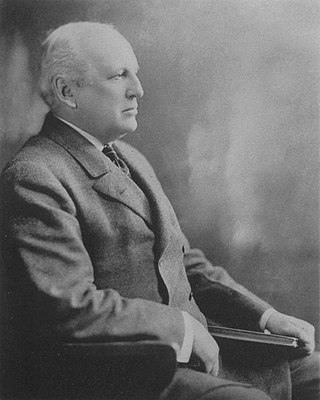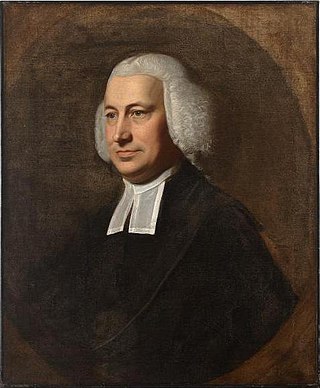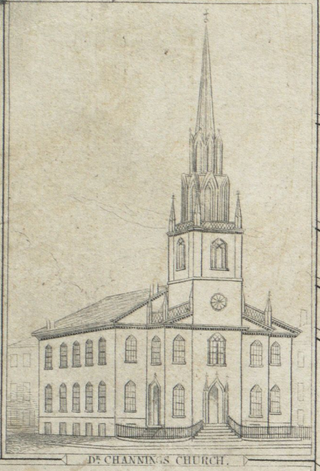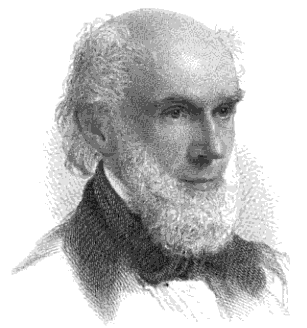
Unitarian Universalism is a liberal religious movement characterized by a "free and responsible search for truth and meaning". Unitarian Universalists assert no creed, but instead are unified by their shared search for spiritual growth. Unitarian Universalists do not have an official, unified corpus of sacred texts. Unitarian Universalist congregations include many atheists, agnostics, deists, and theists; there are churches, fellowships, congregations, and societies around the world.
Thomas Shepard was an English, afterwards American Puritan minister and a significant figure in early colonial New England.

The Universalist Church of West Hartford is a Unitarian Universalist congregation in West Hartford, Connecticut.

United First Parish Church is an American Unitarian Universalist congregation in Quincy, Massachusetts, established as the parish church of Quincy in 1639. The current building was constructed in 1828 by Boston stonecutter Abner Joy to designs by Alexander Parris. It was designated a National Historic Landmark on December 30, 1970, for its association with the Adams family, who funded its construction and four members are buried there.

The Arlington Street Church is a Unitarian Universalist church across from the Public Garden in Boston, Massachusetts. Because of its geographic prominence and the notable ministers who have served the congregation, the church is considered to be among the most historically important in American Unitarianism and Unitarian Universalism. Completed in 1861, it was designed by Arthur Gilman and Gridley James Fox Bryant to resemble James Gibbs' St. Martin-in-the-Fields in London. The main sanctuary space has 16 large-scale stained-glass windows installed by Tiffany Studios from 1899 to 1930.

Samuel Atkins Eliot II was an American Unitarian minister. In 1898 the American Unitarian Association elected him secretary but in 1900 the position was redesignated as president and Eliot served in that office from inception to 1927, significantly expanding the association's activities and consolidating denominational power in its administration.

Samuel McChord Crothers was an American Unitarian minister with The First Parish in Cambridge. He was a popular essayist.

First Parish Dorchester is a Unitarian Universalist congregation in Dorchester, Massachusetts. It was founded by English Puritans who initially saw themselves as reformers rather than separatists, but increasingly intolerable conditions in England and at the urging of Reverend John White of Dorchester, Dorset, they emigrated to New England. On March 20, 1630 as they set sail from Plymouth, England on the Mary and John, the congregation wrote its founding church covenant. Nearly all of the 140 ship passengers originated in the West Country counties of Somerset, Dorset and Devon. In late May, the ship landed first at what became called Hull, Massachusetts, and then in June at a place called "Mattapan" by the indigenous people including the Massachusett and Wampanoag. The Puritans named their new home "Dorchester Plantation."
Arthur Powell Davies was the minister of All Souls Church, Unitarian in Washington, D.C. from 1944 until his death in 1957. A prolific author of theological books and sermon collections, he came to national prominence in the U.S. through his liberal activism advocating civil rights for African-Americans and women and ethical stands against post-war nuclear proliferation and the methods employed by the American government during the era of McCarthyism.
Unitarianism, as a Christian denominational family of churches, was first defined in Poland-Lithuania and Transylvania in the late 16th century. It was then further developed in England and America until the early 19th century, although theological ancestors are to be found as far back as the early days of Christianity. It matured and reached its classical form in the middle 19th century. Later historical development has been diverse in different countries.

The Unitarian Universalist Church of Medford and The Osgood House are a historic Unitarian Universalist church building and parsonage house at 141 and 147 High Street in Medford, Massachusetts.

Samuel Cooper was a Congregational minister in Boston, Massachusetts, affiliated with the Brattle Street Church. He was born in Boston to William Cooper and Judith Sewall, attended the Boston Latin School, and was graduated from Harvard College in 1743. He was ordained as a minister on May 21, 1746, and served as pastor of the Brattle Street Church, 1747-1783. Members of his parish at the Brattle St. Church included some of the most influential people of the American Revolution: John Hancock, Samuel Adams, Joseph Warren, John Adams, and others. He corresponded with Benjamin Franklin, Charles Hector d'Estaing, Gideon Hawley, Charles Gravier de Vergennes; and was associated with Phillis Wheatley. In 1780, he co-founded the American Academy of Arts and Sciences. He served as "chaplain to the General Court" 1758-1770 and 1777-1783. Around 1783 Harvard College offered Cooper the position of college president, but Cooper declined. In September 1746 he married Judith Bulfinch; they had two daughters. A portrait of Cooper by John Singleton Copley now resides in the collection of the Massachusetts Historical Society.

The Federal Street Church was a congregational Unitarian church in Boston, Massachusetts. Organized in 1727, the originally Presbyterian congregation changed in 1786 to "Congregationalism", then adopted the liberal theology of its fifth Senior Minister, William Ellery Channing, (1780–1842). For most of the 18th century the church was known as the Long Lane Meeting-House. In 1788, state leaders met in the relatively spacious building to determine Massachusetts' ratification of the United States Constitution. Thereafter the church renamed itself the Federal Street Church in honor of the event. In 1803, it called William Ellery Channing, (1780–1842), as its minister who defined "Unitarian Christianity" and launched the Unitarian movement, making the Federal Street Church one of the first to define itself as Unitarian.

Ezra Stiles Gannett was a Unitarian minister in Boston, Massachusetts.
Frederick Lucian Hosmer was an American Unitarian minister who served congregations in Massachusetts, Illinois, Ohio, Missouri, and California and who wrote many significant hymns. Beginning in 1875 and continuing for nearly four decades, he and William Channing Gannett worked together, making a contribution to hymnody comparable to that of the "two Sams," Longfellow and Johnson, a generation earlier.

Gellionnen Chapel is a Unitarian place of worship near Pontardawe, South Wales, United Kingdom. The chapel was first built in 1692 by Protestant dissenters, becoming Unitarian in the late 18th century. It is a member of the General Assembly of Unitarian and Free Christian Churches, the umbrella body for British Unitarians. Gellionnen Chapel is the oldest Dissenting chapel in the Swansea Valley, is one of the oldest surviving chapels in the region and is a Grade II* listed building.

Congregationalism in the United States consists of Protestant churches in the Reformed tradition that have a congregational form of church government and trace their origins mainly to Puritan settlers of colonial New England. Congregational churches in other parts of the world are often related to these in the United States due to American missionary activities.

Church of Our Father was the first Unitarian church established in Atlanta, Georgia. The church was organized on March 27, 1883, by Rev. George Leonard Chaney, a Boston minister. Rev. Chaney initially held Sunday services in the Senate Chamber, Concordia Hall and the United States Courtroom. A church building was constructed at the corner of North Forsyth and Church Street and dedicated on April 23, 1884. The original building was demolished in 1900.

The First Universalist Church of Atlanta, organized in 1895, re-established a Universalist presence in Atlanta, Georgia. Initial missionary efforts in 1879 were short-lived and failed to establish a permanent presence in the city. With the explicit assistance the Young People's Christian Union, this second missionary effort enabled the Universalists to sustain their presence and construct a church building on East Harris in 1900. The Universalists occupied the church until 1918 when they merged with Atlanta's Unitarians.

The Old Burying Ground, or Old Burial Ground, is a historic cemetery in Cambridge, Massachusetts, United States, located just outside Harvard Square. The cemetery opened in 1635.


















